Fatigue

Description
Both SN curve and Goodman diagram are commonly used approaches to study fatigue in engineering and material science.
SN curve is a graphical representation of the relationship between the applied cyclic stress amplitude (S) and the number of cycles to failure (N) for a given material. It is commonly used to determine the fatigue strength of materials and to estimate their fatigue life under a specific loading condition. The SN curve approach assumes that the fatigue failure is related to the number of cycles to failure and that the maximum stress amplitude is the main factor affecting fatigue life.
Goodman diagram, on the other hand, is a method for assessing fatigue failure in materials subjected to combined loading conditions, such as fluctuating bending and axial stresses. It plots the alternating stress amplitude (Sa) versus the mean stress (Sm) in a material and shows the region of safe operation for a given material. The Goodman diagram approach assumes that the fatigue failure is related to both the maximum and minimum stresses in the material and that the mean stress can significantly affect the fatigue life.
In summary, the SN curve approach is used to study fatigue in materials subjected to uniaxial loading conditions, while the Goodman diagram is used for materials subjected to combined loading conditions. Both approaches have their advantages and limitations, and the choice of the appropriate method depends on the loading conditions and the specific material being studied.
The Coffin-Manson relation is an empirical formula that describes the relationship between the number of cycles to failure and the plastic strain amplitude of a material subjected to cyclic loading. It is often used in fatigue analysis to predict the fatigue life of materials under cyclic loading conditions.
The Coffin-Manson relation is given by the following equation:
?_pl = A * (N_f)^(-b)
where ?_pl is the plastic strain amplitude, N_f is the number of cycles to failure, A and b are material constants that depend on the material properties and the loading conditions.
The Coffin-Manson relation is derived from experimental data and is typically used for metals and alloys subjected to low cycle fatigue (LCF) loading conditions. The relation assumes that the material undergoes plastic deformation during each loading cycle, and the accumulation of plastic deformation leads to crack initiation and eventual failure.
The Coffin-Manson relation can be used to estimate the fatigue life of a material under cyclic loading conditions, given the plastic strain amplitude and the material constants. However, it should be noted that the relation is only valid within the range of plastic strain amplitudes and loading conditions for which it was derived, and its accuracy may be affected by factors such as stress concentration, material defects, and environmental effects.
Calculation Preview
Full download access to any calculation is available to users with a paid or awarded subscription (XLC Pro).
Subscriptions are free to contributors to the site, alternatively they can be purchased.
Click here for information on subscriptions.





